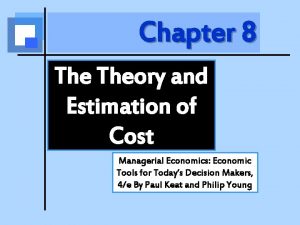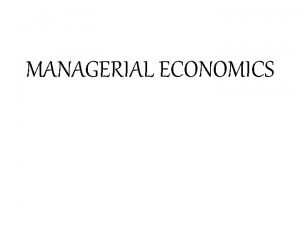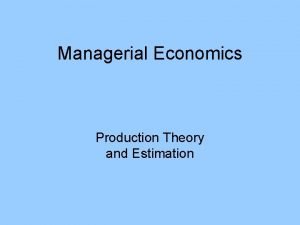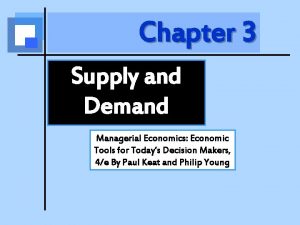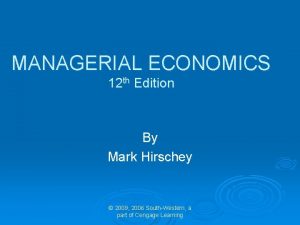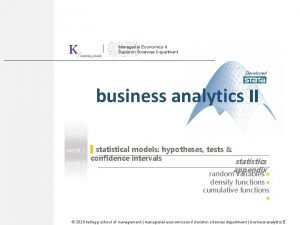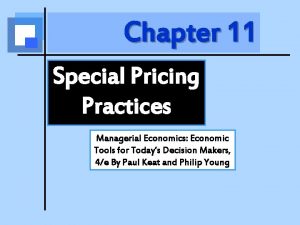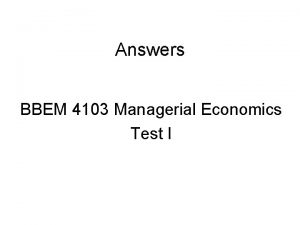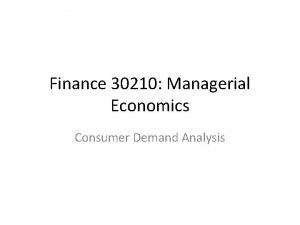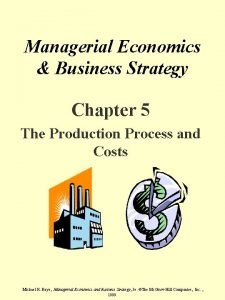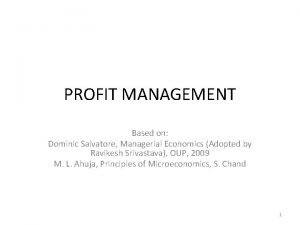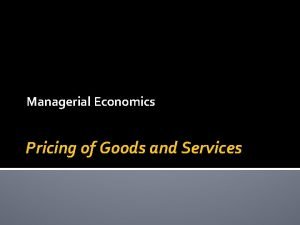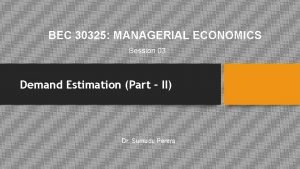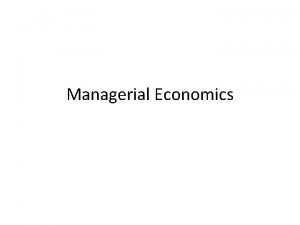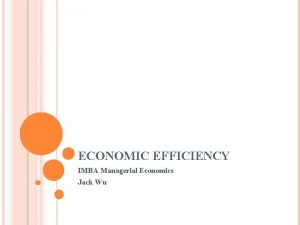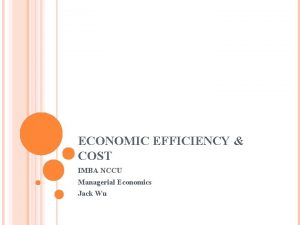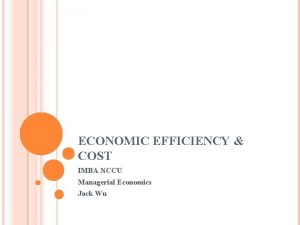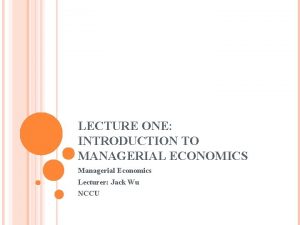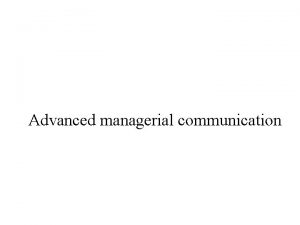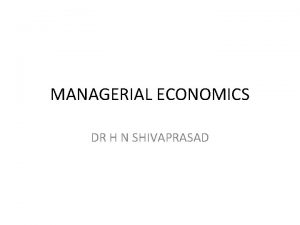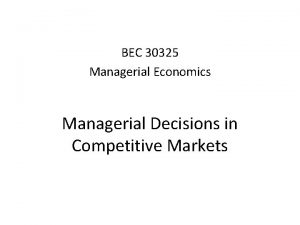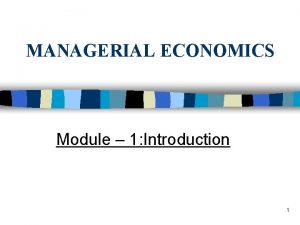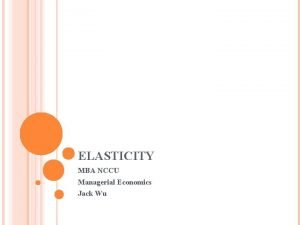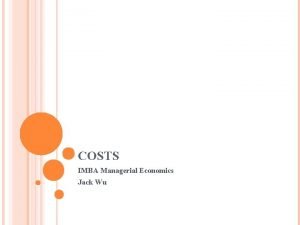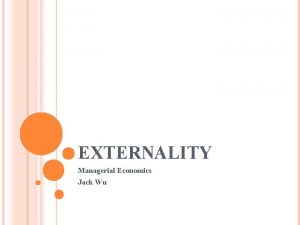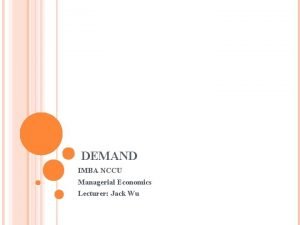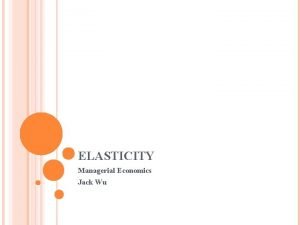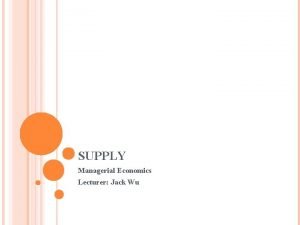ECONOMIC EFFICIENCY Managerial Economics Jack Wu ECONOMIC EFFICIENCY




























- Slides: 28

ECONOMIC EFFICIENCY Managerial Economics Jack Wu

ECONOMIC EFFICIENCY

ECON EFFICIENCY: CONDITIONS for all users, same marginal benefit for all suppliers, same marginal cost marginal benefit = marginal cost

EQUAL MARGINAL BENEFIT if not equal provide more to user with higher marginal benefit take away from user with lower marginal benefit

EQUAL MARGINAL COST if not equal supplier with lower marginal cost should produce more supplier with higher marginal cost should produce less

MARGINAL BENEFIT/COST if marginal benefit > marginal cost, produce more of the item if marginal benefit > marginal cost, produce less of the item

ECONOMIC EFFICIENCY V. S. TECHNICAL EFFICIENCY Contrast economic efficiency vis-à-vis technical efficiency Technical efficiency producing at lowest possible cost doesn’t consider how much benefit the item provides

ADAM SMITH’S INVISIBLE HAND: PRICE Competitive market achieves three sufficient condition for economic efficiency: buyers and sellers in a market system act independently and selfishly, yet the overall outcome is efficient i) users buy until marginal benefit equals price; ii) producers supply until marginal cost equals prices; iii) users and producers face same price.

u. Outcome INVISIBLE HAND of price competition in market w w w Marginal benefit = price Marginal cost = price Single price in market

EXAMPLE OF INVISIBLE HAND Major policy issue: how to allocate licenses for 3 G wireless telecommunications; “beauty contest” -- France auction – Germany, UK, US pioneer: in early 1990 s, US Federal Communications Commission showed that spectrum licenses were worth billions; created pressure on other governments to allocate by auction and not favoritism. Auction ensures that item goes to user with highest marginal benefit.

INVISIBLE HAND Market system (price system): Economic system in which resources are allocated through the independent decisions of buyers and sellers, guided by freely moving prices. Successes of market system West/East Germany North/South Korea China after Deng Xiaoping’s reforms

DE-CENTRALIZATION create internal market if there is a competitive market for an item, set transfer price equal to market price consuming units should be allowed to outsource Note: Transfer price: price charged for the sale of an item within an organization; Outsourcing: purchase of services or supplies from external sources

DECENTRALIZATION Within organization For all users, marginal benefit = transfer price For all producers, marginal cost = transfer price Marginal benefit = transfer price = marginal cost

UCLA ANDERSON SCHOOL, 1989 Half an invisible hand is worse than none priced photocopying paper free bond paper

PRICE CEILING Upper limit that sellers can charge and buyers can pay rent control regulated price for electricity

Price ($ per month) RENT CONTROL: EQUILIBRIUM 1100 b 1000 900 0 supply equilibrium excess demand 290 300 demand 310 Quantity (Thousand units a month)

Price ($ per month) RENT CONTROL: SURPLUSES buyer surplus gain = cfeg buyer surplus loss = dgb seller surplus loss = cfeg + geb d 1100 1000 c 900 f b g supply e demand 0 290 300 310 Quantity (Thousand units a month)

RENT CONTROL: LOSSES deadweight losses -- sellers willing to provide item at price that buyers willing to pay, but provision doesn’t occur price elasticities of demand supply _demand more inelastic --> larger loss _ supply more elastic --> larger loss

PRICE FLOOR Lower limit that sellers can charge and buyers can pay minimum wage agricultural price supports

Wage ($ per hour) MINIMUM WAGE: EQUILIBRIUM a excess supply 4. 20 b 4. 00 equilibrium c 0 demand 8 10 11 Quantity (Billion worker-hours a week)

Wage ($ per hour) MINIMUM WAGE: SURPLUSES seller surplus gain = fdge seller surplus loss = ghb buyer surplus loss = fdge + egb a 4. 20 4. 00 f d supply e b g h c 0 demand 8 10 11 Quantity (Billion worker-hours a week)

MINIMUM WAGE: LOSSES deadweight losses -- sellers willing to provide item at price that buyers willing to pay, but provision doesn’t occur price elasticities of demand supply _supply more inelastic --> larger loss _demand more elastic --> larger loss

TAX: COMMODITY TAX “the only two sure things in life are death and taxes” buyer’s price - tax = seller’s price payment vis-à-vis incidence US: airlines pay tax Asia: passengers pay

Price ($ per ticket) TAX: EQUILIBRIUM 804 $10 e 800 794 0 supply b h 900 demand 920 Quantity (Thousand tickets a year)

TAX: SURPLUSES Price ($ per ticket) buyer surplus loss = fdge + egb seller surplus loss = djhg + ghb revenue gain = fdge + djhg 804 f 800 d 794 j 0 $10 e g b h 900 supply demand 920 Quantity (Thousand tickets a year)

INCIDENCE incidence and deadweight loss depend on price elasticities of demand supply ideal tax (no deadweight loss): inelastic demand/supply who pays the tax not relevant

RETAILING: HOW SHOULD MANUFACTURER CUT PRICE? Wholesale price cut: Will retailers pass on the price cut? Coupons: Will this provide consumers with more effective price cut?

INCIDENCE: REDUCING RETAIL PRICES
 Fundamental concepts of managerial economics
Fundamental concepts of managerial economics Main characters of jack and the beanstalk
Main characters of jack and the beanstalk Estimation of cost function in managerial economics
Estimation of cost function in managerial economics Cost theory and estimation in managerial economics
Cost theory and estimation in managerial economics Managerial economics
Managerial economics Empirical production function managerial economics
Empirical production function managerial economics Managerial economics
Managerial economics Supply analysis in managerial economics
Supply analysis in managerial economics Managerial economics hirschey
Managerial economics hirschey Managerial economics and decision sciences
Managerial economics and decision sciences Managerial economics applications strategy and tactics
Managerial economics applications strategy and tactics Managerial economics chapter 1
Managerial economics chapter 1 Transfer pricing in managerial economics
Transfer pricing in managerial economics Nature of management accounting
Nature of management accounting Managerial economics questions and answers
Managerial economics questions and answers Managerial economics
Managerial economics Firm in economics
Firm in economics Incremental reasoning
Incremental reasoning Scope of managerial economics
Scope of managerial economics Managerial economics demand analysis
Managerial economics demand analysis Equi marginal principle in managerial economics
Equi marginal principle in managerial economics Risk and uncertainty in managerial economics
Risk and uncertainty in managerial economics Managerial economics chapter 5
Managerial economics chapter 5 Profit management in managerial economics
Profit management in managerial economics Transfer pricing in managerial economics
Transfer pricing in managerial economics Managerial economics
Managerial economics Demand estimation in managerial economics
Demand estimation in managerial economics Managerial economics
Managerial economics How managerial economics is useful to engineers
How managerial economics is useful to engineers


